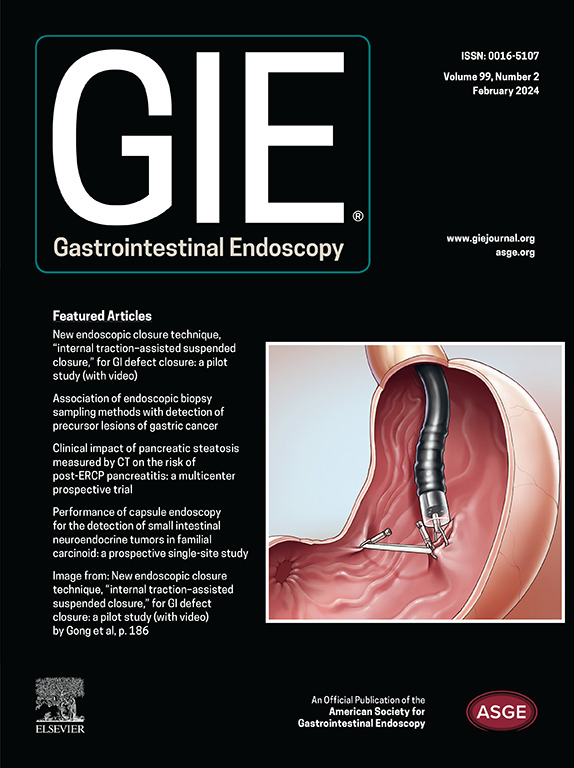Development and validation of a machine learning–based, point-of-care risk calculator for post-ERCP pancreatitis and prophylaxis selection
IF 6.7
1区 医学
Q1 GASTROENTEROLOGY & HEPATOLOGY
引用次数: 0
Abstract
Background and Aims
A robust model of post-ERCP pancreatitis (PEP) risk is not currently available. We aimed to develop a machine learning–based tool for PEP risk prediction to aid in clinical decision making related to periprocedural prophylaxis selection and postprocedural monitoring.
Methods
Feature selection, model training, and validation were performed using patient-level data from 12 randomized controlled trials. A gradient-boosted machine (GBM) model was trained to estimate PEP risk, and the performance of the resulting model was evaluated using the area under the receiver operating curve (AUC) with 5-fold cross-validation. A web-based clinical decision-making tool was created, and a prospective pilot study was performed using data from ERCPs performed at the Johns Hopkins Hospital over a 1-month period.
Results
A total of 7389 patients were included in the GBM with an 8.6% rate of PEP. The model was trained on 20 PEP risk factors and 5 prophylactic interventions (rectal nonsteroidal anti-inflammatory drugs [NSAIDs], aggressive hydration, combined rectal NSAIDs and aggressive hydration, pancreatic duct stenting, and combined rectal NSAIDs and pancreatic duct stenting). The resulting GBM model had an AUC of 0.70 (65% specificity, 65% sensitivity, 95% negative predictive value, and 15% positive predictive value). A total of 135 patients were included in the prospective pilot study, resulting in an AUC of 0.74.
Conclusions
This study demonstrates the feasibility and utility of a novel machine learning–based PEP risk estimation tool with high negative predictive value to aid in prophylaxis selection and identify patients at low risk who may not require extended postprocedure monitoring.

开发并验证基于机器学习的医护点风险计算器,用于ERCP 后胰腺炎和预防措施的选择。
背景和目的:目前还没有关于ERCP术后胰腺炎(PEP)风险的可靠模型。我们的目标是开发一种基于机器学习的 PEP 风险预测工具,以帮助与围手术期预防选择和手术后监测相关的临床决策:方法: 使用来自 12 项随机对照试验的患者级数据进行特征选择、模型训练和验证。训练梯度增强型机器(GBM)模型来估计PEP风险,并通过接收者操作曲线下面积(AUC)和5倍交叉验证来评估模型的性能。我们创建了一个基于网络的临床决策工具,并利用约翰-霍普金斯医院在一个月内进行的ERCP数据开展了一项前瞻性试验研究:共有 7389 名患者被纳入 GBM,PEP 率为 8.6%。该模型根据 20 个 PEP 风险因素和 5 种预防性干预措施(直肠非甾体类抗炎药 [NSAID]、积极补液、直肠非甾体类抗炎药和积极补液联合应用、胰管 [PD] 支架植入术以及直肠非甾体类抗炎药和胰管支架植入术联合应用)进行了训练。由此得出的 GBM 模型的 AUC 为 0.70(特异性 65%,敏感性 65%,阴性预测值 95%,阳性预测值 15%)。前瞻性试点研究共纳入 135 名患者,得出的 AUC 为 0.74:这项研究证明了基于机器学习的新型 PEP 风险评估工具的可行性和实用性,该工具具有较高的阴性预测值,可帮助选择预防措施,并识别可能不需要延长术后监测时间的低风险患者。
本文章由计算机程序翻译,如有差异,请以英文原文为准。
求助全文
约1分钟内获得全文
求助全文
来源期刊

Gastrointestinal endoscopy
医学-胃肠肝病学
CiteScore
10.30
自引率
7.80%
发文量
1441
审稿时长
38 days
期刊介绍:
Gastrointestinal Endoscopy is a journal publishing original, peer-reviewed articles on endoscopic procedures for studying, diagnosing, and treating digestive diseases. It covers outcomes research, prospective studies, and controlled trials of new endoscopic instruments and treatment methods. The online features include full-text articles, video and audio clips, and MEDLINE links. The journal serves as an international forum for the latest developments in the specialty, offering challenging reports from authorities worldwide. It also publishes abstracts of significant articles from other clinical publications, accompanied by expert commentaries.
 求助内容:
求助内容: 应助结果提醒方式:
应助结果提醒方式:


